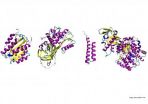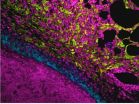(Press-News.org) Proteins are elementary building blocks of life. They often perform vital functions. In order to become active, proteins have to fold into three-dimensional structures. Misfolding of proteins leads to diseases such as Alzheimer's or Creutzfeld-Jakob. So which strategies did nature develop over the course of evolution to improve protein folding?
To examine this question, the chemist Dr. Frauke Gräter (Heidelberg Institute for Theoretical Studies) looked far back into the history of the Earth. Together with her colleague Prof. Gustavo Caetano-Anolles at the University of Illinois at Urbana-Champaign, she used computer analyses to examine the folding speed of all currently known proteins. The researchers have seen the following trend: For most of protein evolution, the folding speed increased, from archaea to multicellular organisms. However, 1.5 billion years ago, more complex structures emerged and caused a biological 'Big Bang'. This has led to the development of slower-folding protein structures. Remarkably, the tendency towards higher speed in protein origami overall dominated, regardless of the length of amino acid chains constituting the proteins.
"The reason for higher folding speed might be that this makes proteins less susceptible to aggregation, so that they can carry out their tasks faster," says Dr. Frauke Gräter, head of the Molecular Biomechanics research group at HITS.
Genetics and biophysics for large volumes of data
In their work, the researchers used an interdisciplinary approach combining genetics and biophysics. "It is the first analysis to combine all known protein structures and genomes with folding rates as a physical parameter," says Dr. Gräter.
The analysis of 92,000 proteins and 989 genomes can only be tackled with computational methods. The group of Gustavo Caetano-Anolles, head of the Evolutionary Bioinformatics Laboratory at Urbana-Champaign, had originally classified most structurally known proteins from the Protein Database (PDB) according to age. For this study, Minglei Wang in his laboratory identified protein sequences in the genomes, which had the same folding structure as the known proteins. He then applied an algorithm to compare them to each other on a time scale. In this way, it is possible to determine which proteins became part of which organism and when. After that, Cedric Debes, a member of Dr. Gräter's group, applied a mathematical model to predict the folding rate of proteins. The individual folding steps differ in speed and can take from nanoseconds to minutes. No microscope or laser would be able to capture these different time scales for so many proteins. A computer simulation calculating all folding structures in all proteins would take centuries to run on a mainframe computer. This is why the researchers worked with a less data-intensive method. They calculated the folding speed of the single proteins using structures that have been previously determined in experiments: A protein always folds at the same points. If these points are far apart from each other, it takes longer to fold than if they lie close to each other. With the so-called Size-Modified Contact Order (SMCO), it is possible to predict how fast these points will meet and thus how fast the protein will fold, regardless of its length.
"Our results show that in the beginning there were proteins which could not fold very well," Dr. Gräter summarizes. "Over time, nature improved protein folding so that eventually, more complex structures such as the many specialized proteins of humans were able to develop."
Shorter and faster for evolution
Amino acid chains, which make up proteins, also became shorter over the course of evolution. This was another factor contributing to the increase in folding speed, as has been shown in the study.
"Since eukaryotes, i.e. organisms with a cell nucleus, emerged, protein folding became somewhat less crucial," says Frauke Gräter. Since then, nature has developed a complex machinery to prevent and repair misfolded proteins. One example are the so-called chaperones. "It seems as if nature would accept a certain level of disorder in order to develop structures which could not have evolved otherwise."
The number of known genomes and protein structures is continually increasing, thus expanding the data bases for further computer analyses of protein evolution. Frauke Gräter says "With future analyses of protein evolution, it might be possible for us to answer the related question whether proteins became more stable or more flexible over their billion-year-long history of evolution."
INFORMATION:
The study was supported by the Klaus Tschira Foundation and the National Science Foundation of the US.
Scientific publication:
Debès C, Wang M, Caetano-Anollés G, Gräter F (2013) Evolutionary Optimization of Protein Folding. PLOS Comput Biol 9(1): e1002861. doi:10.1371/journal.pcbi.1002861
URL: http://www.ploscompbiol.org/article/info:doi/10.1371/journal.pcbi.1002861
Press contact:
Dr. Peter Saueressig
Public Relations
Heidelberg Institute for Theoretical Studies (HITS)
Fax: 49-6221-533-298
http://www.h-its.org
Scientific Contact:
Dr. Frauke Gräter
Molecular Biomechanics group
Heidelberg Institute for Theoretical Studies (HITS)
Tel: 49-6221-533-267
frauke.graeter@h-its.org
Prof. Dr. Gustavo Caetano-Anollés
Evolutionary Bioinformatics Laboratory
Dep. Of Crop Sciences,
University of Illinois at Urbana-Champaign
332 National Soybean Res Ctr,
1101 West Peabody Drive
Urbana, IL 61801
217-333-8172
gca@illinois.edu
http://cropsci.illinois.edu/directory/gca
HITS
HITS (Heidelberg Institute for Theoretical Studies) is a private, non-profit research institute. As a research institute of the Klaus Tschira Foundation, HITS conducts basic research from astrophysics to cell biology, with a focus on processing and structuring large volumes of data. The institute is jointly managed by Klaus Tschira and Andreas Reuter.
Evolutionary Bioinformatics Laboratory, University of Illinois at Urbana-Champaign
The Evolutionary Bioinformatics Laboratory at the University of Illinois focuses on creative ways to mine, visualize and integrate data from structural and functional genomic research, with a special focus on evolution of macromolecular structure.
Protein origami: Quick folders are the best
The evolution of proteins shows that folding speed is an important factor, say researchers from Heidelberg Institute for Theoretical Studies (HITS) and the University of Illinois at Urbana Champaign in a new study
2013-01-31
ELSE PRESS RELEASES FROM THIS DATE:
A possible answer for protection against chemical/biological agents, fuel leaks, and coffee stains
2013-01-31
A recent discovery funded by the Air Force Office of Scientific Research (AFOSR) may very well lead to a process that not only benefits every uniformed service member of the Department of Defense, but everyone else as well: protection from Chemical/Biological agents, to self-cleaning apparel, to effortless thermal management, to fuel purification as well as enhanced control of leaks—especially oil and fuels.
In 2006, AFOSR Program Manager Dr. Charles Lee funded Professor Gareth McKinley at the Massachusetts Institute of Technology exploring nanocomposite technology ...
Second-generation CT scanner substantially reduces radiation exposure
2013-01-31
OAK BROOK, Ill. (January 31, 2013) – Researchers using a newly approved advanced computed tomography (CT) system were able to significantly reduce radiation exposure in patients undergoing coronary CT angiography (CCTA), according to a new study published online in the journal Radiology.
"Radiation exposure during diagnostic imaging is a substantial public concern," said Marcus Y. Chen, M.D., lead author of the study from the advanced cardiovascular imaging laboratory at the National Institutes of Health in Bethesda, Md. "Minimizing radiation exposure while maintaining ...
Corn cobs eyed for bioenergy production
2013-01-31
This press release is available in Spanish.
Corn crop residues are often left on harvested fields to protect soil quality, but they could become an important raw material in cellulosic ethanol production. U.S. Department of Agriculture (USDA) research indicates that soil quality would not decline if post-harvest corn cob residues were removed from fields.
This work, led by Agricultural Research Service (ARS) soil scientist Brian Wienhold, supports the USDA priority of developing new sources of bioenergy. ARS is USDA's chief intramural scientific research agency.
Wienhold ...
Gum disease found to worsen infection in animal model of AIDS
2013-01-31
Texas Biomed scientists in San Antonio have found that moderate gum disease in an animal model exposed to an AIDS- like virus had more viral variants causing infection and greater inflammation. Both of these features have potential negative implications in long term disease progression, including other kinds of infections, the researchers say in a new report.
The public health message from the study is that even mild inflammation in the mouth needs to be controlled because it can lead to more serious consequences, said Luis Giavedoni, Ph. D, a Texas Biomed virologist and ...
Flat boron by the numbers
2013-01-31
It would be a terrible thing if laboratories striving to grow graphene from carbon atoms kept winding up with big pesky diamonds.
"That would be trouble, cleaning out the diamonds so you could do some real work," said Rice University theoretical physicist Boris Yakobson, chuckling at the absurd image.
Yet something like that keeps happening to experimentalists working to grow two-dimensional boron. Boron atoms have a strong preference to clump into three-dimensional shapes rather than assemble into pristine single-atom sheets, like carbon does when it becomes graphene. ...
New study highlights impact of environmental change on older people
2013-01-31
Recent natural disasters illustrate vulnerability of older people: majority of deaths from the Great East Japan Earthquake (2011) and Hurricane Katrina (2005) occurred among older people.
Researchers at the Stockholm Environment Institute at the University of York and Simon Fraser University's Gerontology Research Centre in Canada are calling for better awareness among policy makers and the public of the impact climate change and deteriorating environmental quality will have on an ageing population.
According to UN projections, by 2050, nearly 25 per cent of the global ...
UNC study may lead to treatments that are effective against all MRSA strains
2013-01-31
CHAPEL HILL, N.C. – In the last decade, a new strain of MRSA has emerged that can spread beyond hospital walls, putting everyone at risk of contracting the dangerous bacterial infection. This particular strain of MRSA – known as USA300 – contains a chunk of genes not shared by any other strains, though it is unclear how this unique genetic material enables the bacteria to survive and persist in the community.
Now, research from the University of North Carolina School of Medicine has pinpointed a gene that causes the infection to linger on the skin longer than other strains, ...
How the tilt of a cell-surface receptor prevents cancer
2013-01-31
January 31, 2013, New York, NY and Brussels, Belgium – Clear communication between cells is essential to every aspect of the body's internal function. But since cells can't talk, or send emails, how do they communicate?
The answer, in a nutshell, is by dispatching signaling molecules that selectively bind to protein receptors on the outer surface of other cells with which they must "talk." This activates the tail end of such receptors inside the cell, initiating a cascade of enzymatic reactions, or signaling pathways that reach into the nucleus, turning genes on and off. ...
1 of the key circuits in regulating genes involved in producing blood stem cells is deciphered
2013-01-31
Researchers from the group on stem cells and cancer at IMIM (Hospital del Mar Medical Research Institute) have deciphered one of the gene regulation circuits which would make it possible to generate hematopoietic blood cells, i.e. blood tissue stem cells. This finding is essential to generate these cells in a laboratory in the future, a therapy that could benefit patients with leukaemia or other diseases who need a transplant and who, in many cases, do not have a compatible donor.
In the process of generating stem cells, many molecule signals intervene which, through ...
In the planetary nursery
2013-01-31
This press release is available in German.
The disk surrounding the young star TW Hydrae is regarded as a prototypical example of planetary nurseries. Due to its comparatively close proximity of 176 light-years, the object plays a key role in cosmological birth models. Using the Herschel Space Telescope, researchers including Thomas Henning from the Max Planck Institute for Astronomy in Heidelberg have, for the first time, determined the mass of the disk very precisely. The new value is larger than previous estimates and proves that planets similar to those of our solar ...
LAST 30 PRESS RELEASES:
When is it time to jump? The boiling frog problem of AI use in physics education
Twitter data reveals partisan divide in understanding why pollen season's getting worse
AI is quick but risky for updating old software
Revolutionizing biosecurity: new multi-omics framework to transform invasive species management
From ancient herb to modern medicine: new review unveils the multi-targeted healing potential of Borago officinalis
Building a global scientific community: Biological Diversity Journal announces dual recruitment of Editorial Board and Youth Editorial Board members
Microbes that break down antibiotics help protect ecosystems under drug pollution
Smart biochar that remembers pollutants offers a new way to clean water and recycle biomass
Rice genes matter more than domestication in shaping plant microbiomes
Ticking time bomb: Some farmers report as many as 70 tick encounters over a 6-month period
Turning garden and crop waste into plastics
Scientists discover ‘platypus galaxies’ in the early universe
Seeing thyroid cancer in a new light: when AI meets label-free imaging in the operating room
Neutrophil-to-lymphocyte ratio may aid risk stratification in depressive disorder
2026 Seismological Society of America Annual Meeting
AI-powered ECG analysis offers promising path for early detection of chronic obstructive pulmonary disease, says Mount Sinai researchers
GIMM uncovers flaws in lab-grown heart cells and paves the way for improved treatments
Cracking the evolutionary code of sleep
Medications could help the aging brain cope with surgery, memory impairment
Back pain linked to worse sleep years later in men over 65, according to study
CDC urges ‘shared decision-making’ on some childhood vaccines; many unclear about what that means
New research finds that an ‘equal treatment’ approach to economic opportunity advertising can backfire
Researchers create shape-shifting, self-navigating microparticles
Science army mobilizes to map US soil microbiome
Researchers develop new tools to turn grain crops into biosensors
Do supervised consumption sites bring increased crime? Study suggests that’s a myth
New mass spec innovation could transform research
Maternal nativity, race, and ethnicity and infant mortality in the US
Migration-related trauma among asylum seekers exposed to the migrant protection protocols
Jupiter’s moon Europa has a seafloor that may be quiet and lifeless
[Press-News.org] Protein origami: Quick folders are the bestThe evolution of proteins shows that folding speed is an important factor, say researchers from Heidelberg Institute for Theoretical Studies (HITS) and the University of Illinois at Urbana Champaign in a new study


